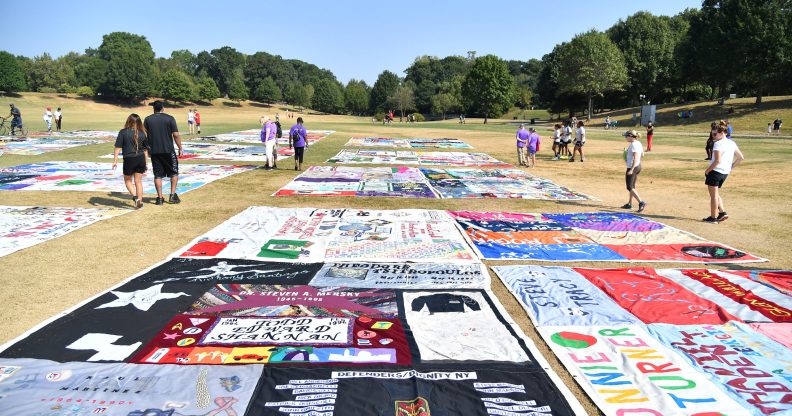Leftover scraps from the historic AIDS Memorial Quilt are now being used to make coronavirus masks

Patrons observe the AIDS Memorial Quilt during the AIDS Walk Atlanta in September 29, 2019 in Atlanta, Georgia. (Paras Griffin/Getty Images)
Thirty years since HIV activists began working on the AIDS Memorial Quilt to remember their fallen comrades, leftover scraps of the materials used to make it are helping people during the coronavirus pandemic.
The AIDS Memorial Quilt is an ongoing community project made up of 48,000 panels, each remembering a person who died from AIDS-related complications.
Activists began sewing it in 1987 as a way of remembering their friends, many of whom didn’t get proper funerals or memorials services because of the stigma surrounding HIV.
Gert McMullin, one of the first people to begin sewing the quilt, said that coronavirus is making her remember what it was like for the LGBT+ community.
“During the AIDS crisis, I could go and do something,” she told People. “But now, I can’t. I’m not used to sitting around and [not] helping people.”
So, she has dusted off her sewing machine and got to work sewing face masks using leftover fabric from the quilt.
Face masks made from AIDS Memorial Quilt helping homeless people, drug users and those who support them.
They are being sent to facilities run by Bay Area Community Services in San Francisco – facilities that support homeless people and drug users – and are being used by service users as well as employees.
The AIDS Memorial Quilt, which has been touring the US, was supposed to be displayed by the National AIDS Memorial earlier this month, but the ongoing pandemic put that plan on hold.
McMullin has sewn hundreds of the 54-tonne quilt’s panels, making her the biggest contributor. She is now its custodian and an employee of the National AIDS Memorial.
Cleve Jones, an AIDS activist, was the one who came up with the idea for the quilt in 1985.
At one candlelit vigil in 1985, he asked his friends to write the name of their dead loved ones on placards, and this sparked the concept of turning those placards into patches that could be sewn into a quilt.
“We in the LGBT community understood what was happening in the early 80s,” said Jones.
“We had to create systems of care and support ourselves.”

